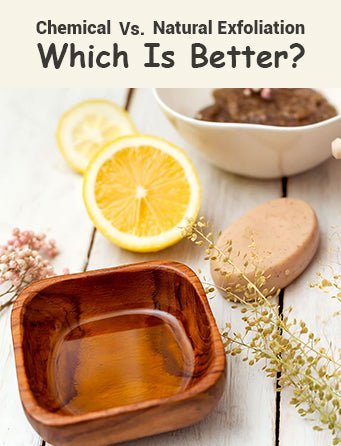
Chemical Vs. Natural Exfoliation: Which Is Better?
Share
Before getting into the different types of exfoliation, it is important to understand what exfoliation is. Exfoliation is the process of removing the layer of dead cells on the outermost layer of your skin, using either a scrub or a chemical exfoliant. This helps improve the appearance and texture of your skin.

Although you are supposed to shed dead skin cells naturally, sometimes it is not that straightforward. There are instances in which dead skin does not completely shed which causes flakiness, dry patches, and clogged pores.
- Exfoliation helps get rid of that layer of dead skin cells and brings out fresh-looking skin.
- It removes dirt, gunk, oil, build-up, debris, etc.
- It improves circulation by stimulating healthy blood flow leaving your skin with a healthy glow
- It also helps other skincare products absorb better into your skin as there is less buildup.
Skipping exfoliation could also be the reason behind getting clogged pores, acne, blackheads, whiteheads, ingrown hair, and texture, which is why it is a very important step to include in your skincare routine.
How often should you exfoliate?
To keep your skin feeling healthy and fresh, you must exfoliate at least twice a week. This is the ideal number of times skin should be exfoliated otherwise over-exfoliation can strip your skin of its necessary oils and moisture and actually cause a lot of irritation and redness.
It is essential to establish the correct balance so as to not harm your skin in the process of actually taking care of it. If you have sensitive skin, exfoliating even once a week might be enough for you.
In case you use makeup on the daily or even wear sunscreen, exfoliation is an important step that should be a part of your regimen. How often you exfoliate may also depend on the type of exfoliants you use.
Natural exfoliators vs. Chemical ones
When it comes to exfoliation, you have two options
- Chemical Exfoliation
Chemical exfoliation usually involves AHAs, BHAs, lactic acid, retinol, etc. These acids work by dissolving the dead skin cells and are removed when you next wash your skin.
- Physical Exfoliation (Natural Exfoliation)
With physical exfoliation, there are granules that manually get rid of the layer of dead skin cells. This includes natural DIY scrubs you can make with ingredients you can find at home and some OTC products.
Both, chemical and natural (physical) exfoliations have their pros and cons
Natural or physical exfoliation may be a little tricky for sensitive skin types as the scrubbing motion may cause irritation to the skin but so will other forms of exfoliation.
It is always better to do a patch test, regardless of the type of exfoliation method you choose. You never know what your skin reacts badly to.
The downside of chemical exfoliation
Using chemical exfoliation over time can become very harmful to your skin. It can make your skin prone to redness and irritation. Having too many chemicals be a part of your skincare routine can be counterproductive as one may cancel out the effect of the other.
You have to be very particular with the aftercare of using a chemical exfoliant. If not followed up by a proper moisturizer and SPF, it is more likely to damage your skin than help it.
Aftercare
Following up with a moisturizer after you are done exfoliating is extremely important. This is what keeps your skin feeling soft and looking radiant. You also must be particular about protecting your skin from the sun.
If you are exfoliating correctly, and according to your skin type, then the process should not be stripping your skin of its natural moisture.
Takeaway
Being regular with exfoliation promotes the production of collagen and results in more youthful-looking skin. Natural scrubs are easy to make and you can find most of the ingredients very easily. You might even have most of these handy.
It all comes down to personal preference, whether you go with natural exfoliators or physical one. There is no one-size-fits-all solution when it comes to skincare. You must tailor your routine according to your skin type and what you know your skin needs. A lot of the things that work for other people might not work for you. It is a process, and with patience and trial and error, you will find what your skin likes.
